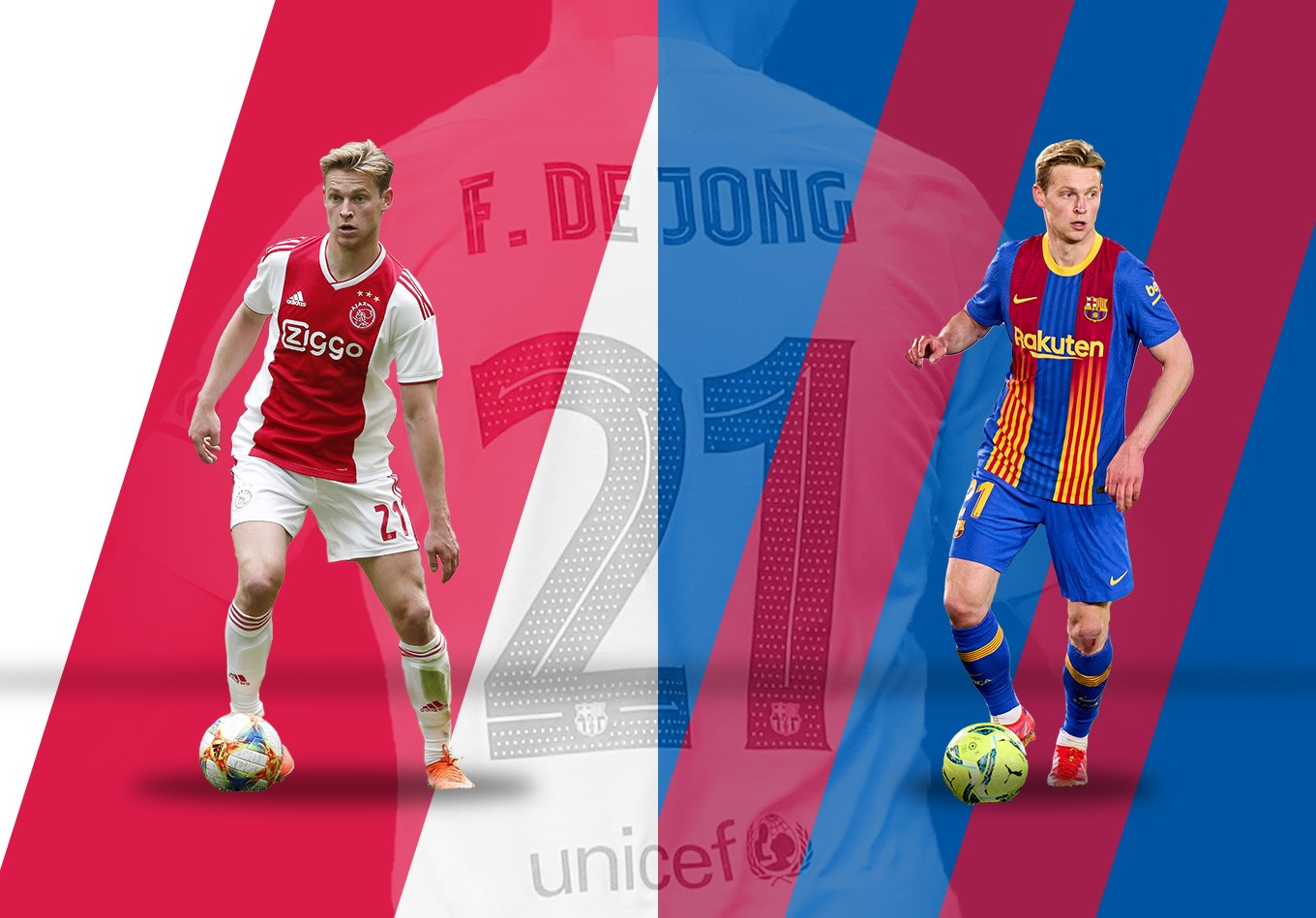2019-20 was a trophyless disappointment for Barcelona, and what they got from Frenkie de Jong wasn’t quite what they saw from him at Ajax. That’s changed in 2020-21. It was on display in the Copa del Rey final, and the midfielder can now help flip what started as another season of frustration by chasing down Atlético Madrid for La Liga’s silverware.
Barcelona are forever set on having a Barcelona Midfield™, and that never felt unreasonable until it got too good to replace.
They’ve understandably struggled to replenish it since Xavi and Andrés Iniesta left the club, and the very presence of those names in Paragraph No. 2 of a story about another midfielder a.) is annoying, and b.) suggests just how present the idea of those two remains. There are voids in a room that can be covered over with the placement of a potted plant. And there are voids that shoot into space.
But it’s been three years since Iniesta’s departure and there was no easy answer. The club’s comparative decline – in many ways understandable – has been as pronounced as the annual Barcelona Champions League Exit™ we’ve come to know. We should by now be resetting our expectations from an 11-out-of-10 midfield to what over time we’re used to at Barca – say, 9 out of 10.
And Frenkie de Jong can be a 9 out of 10. It just didn’t happen immediately.
A lost year to some at Barcelona may be one in which they don’t win La Liga. To others, it may be the UEFA Champions League. Or for some, expectations may be so high that it’s treble or bust. Last season was a lost year to just about everyone. It was de Jong’s first.
It’s rather unlike Barcelona to allow for a learning curve. Learning happens at La Masia. Learning happens at another club. Learning – ask Arthur – does not happen before 95,000 at Camp Nou in the twilight of Lionel Messi when every trophy could be his last. But calling it learning for de Jong would be wrong. It was adjusting. It was settling. It was beginning to know his teammates the way he knew his Ajax teammates. He already knew how to do what he still needed to prove. What happened in Amsterdam with a football and two boots was also possible in Catalonia.
This season for a long while felt like another lost year at Barcelona, one in which a decline that’s been in progress for half a decade felt to have bottomed out in the early days of Ronald Koeman. The Blaugrana were only ever serious Champions League contenders the way Apple users view mobile competition: Oh, that’s cute. Nice pen.
Until recently, Barca didn’t feel like serious La Liga contenders either. They might not have against Real Madrid on April 10, but that did nothing to end title hopes. The Copa del Rey final – granted against Athletic Bilbao – felt whole. It felt complete because it was a Barcelona Midfield ™ performance, and at the centre of it was a midfielder who in winning his first trophy at the club put the first of potentially two domestic stamps on a favourable individual season. He finished with a goal and two assists, completed all of his final-third passes and played a supporting role in Messi being Messi.
It passed the eye test and more, but to quantify this, we also need to look at the less-favourable season for de Jong and the level he rose to before arriving in Spain.
Frenkie de Jong’s Ajax had eyes in the back of its head. It was a school of fish that wordlessly and collectively knew the next sudden pirouette. It was an it, a collective noun in the singular sense, not a they.
The Eredivisie may not be La Liga, but the Ajax team de Jong led was quite obviously unconcerned, giving the club their first domestic title in five seasons but also eliminating Real Madrid and Juventus in the Champions League knockout stages on their way to the semi-finals. That Ajax side scored 119 goals in 34 league games for a +87 goal difference. Inflated numbers indeed, but those goals are the basis for the individual numbers de Jong now has to live up to in a tougher league. And after a mediocre 2019-20, he’s not exactly falling short.
De Jong Attacking Numbers:
| Club | Matches | Goals | xG | Shots | Assists | xA | Chances Created |
|---|---|---|---|---|---|---|---|
| Ajax 18-19 | 52 | 0.06 | 0.05 | 0.8 | 0.06 | 0.17 | 1.41 |
| Barcelona 19-20 | 42 | 0.06 | 0.05 | 0.22 | 0.08 | 0.11 | 0.84 |
| Barcelona 20-21 | 44 | 0.16 | 0.15 | 0.46 | 0.16 | 0.12 | 1.02 |
Attacking numbers like these are good to know but, given the nature of de Jong’s position, less consequential than the numbers we’ll get to. Yeah, he created 1.41 chances per 90 at Ajax, but his teammates on the wings Hakim Ziyech and Dušan Tadić were combining to create nearly seven. It’s nice that in 2020-21 we begin to see returns toward his Ajax numbers and that when he does decide to shoot, he’s doing so economically with about half a shot per match returning 0.16 goals. But the generally underwhelming nature of what we’re looking at above begins to tell a story in that we’re talking about a midfielder whose standard attacking data isn’t nearly enough to measure his impact.
Next up, passing and take-ons.
De Jong Passing Numbers:
| Club | Received | Attempted | Completion % | Into Attack 3rd | In Attack 3rd | Completion % | Take-Ons | Completion % |
|---|---|---|---|---|---|---|---|---|
| Ajax 18-19 | 66.6 | 84.1 | 91.2 | 10.1 | 16.4 | 85.4 | 2.61 | 76.6 |
| Barcelona 19-20 | 59.6 | 68.3 | 91.5 | 7.6 | 17.6 | 86.9 | 2.65 | 76.8 |
| Barcelona 20-21 | 66.8 | 77.2 | 92.3 | 8.3 | 17.8 | 88.2 | 1.86 | 85.0 |
In his first season at Barca, de Jong just wasn’t as involved. His passes received and attempted were down. Interestingly, his take-on trends carried over, though this season’s numbers seem to indicate a decision to attempt fewer. The result is higher efficacy. His La Liga take-on success rate (83.6%) is slightly below his percentage in all competitions displayed above, but that still ranks first in the division among those with at least 900 minutes played attempting at least one take-on per match.
And just because his take-ons attempted are down doesn’t mean he’s not progressing the ball with carries. He’s averaging the second-most ball carries (carrying the ball five metres or more) among midfielders in Europe’s top five leagues (26.6) behind Marco Veratti, and 14.8 of those have been progressive, which also ranks second. Those La Liga numbers are up from 21.4 carries per 90 last season with 11.2 progressive.
In the Copa del Rey final last weekend, Barca’s 93.4% pass completion and 93.8% pass completion in the final third were their highest of the season. It was, to date, the culmination of de Jong and Pedri taking over the Barca midfield. Both had a 100% pass completion ending in the final third.
De Jong has eight games with a 100% pass completion rate in the final third for Barcelona, and prior to the 30 made in the final third he completed on Sunday, his game high with 100% completion in the final third was 23.
But even so, passing percentages only tell us so much. For de Jong, sequences help us understand a bit more of the style and substance behind those passes. Below, we see the average starting location of his sequences measured from the Barcelona goal, their duration, their distance progressed up pitch, their direct speed measured in metres per second progressed, and the average number of passes in de Jong’s sequences.
De Jong Sequence Numbers:
| Club | Avg. Start Distance (m) | Time (secs) | Distance (m) | Direct Speed (m/s) | Avg. Passes |
|---|---|---|---|---|---|
| Ajax 18-19 | 46.9 | 17.9 | 23.1 | 1.29 | 6.3 |
| Barcelona 19-20 | 45.7 | 22.4 | 22.0 | 0.98 | 8.3 |
| Barcelona 20-21 | 44.4 | 22.5 | 25.9 | 1.15 | 8.6 |
The direct speed of his sequences is closer to that of 2018-19 at Ajax than it is to last season’s, so it seems Barca when involving de Jong are finding something of a middle ground with pace. His average sequence time is more of the traditional Barcelona world than the Ajax world, but they’re resulting in nearly 26 metres progressed up pitch. So his sequences are starting deeper but progressing farther. If you remove his European and cup matches, in the 2018-19 Eredivisie, he ranked third among midfielders in average sequence length (24.7). He’s at 26.2 in La Liga, which ranks first among central midfielders in the top five European leagues.
And the end result is easier to see this season than it was last with more of those sequences resulting in something productive.
De Jong Sequence Results:
| Club | End in Attack 3rd | Ends in Shot | Ends in Goal | Started Ends in Goal |
|---|---|---|---|---|
| Ajax 18-19 | 35.3 | 6.1 | 0.71 | 0.22 |
| Barcelona 19-20 | 28.3 | 3.71 | 0.53 | 0.11 |
| Barcelona 20-21 | 32.4 | 5.57 | 0.84 | 0.21 |
The sequences de Jong is involved in ending in a shot took a substantial dip last season. They’re now back up near his Ajax mark, as are the sequences he’s started that end in a goal. And the sequences he’s involved in that end with a goal are notably surpassing even that of the 119-goal Ajax team.
In La Liga alone, he’s involved in 0.78 sequences ending in a goal per 90, which among central midfielders is elite company.
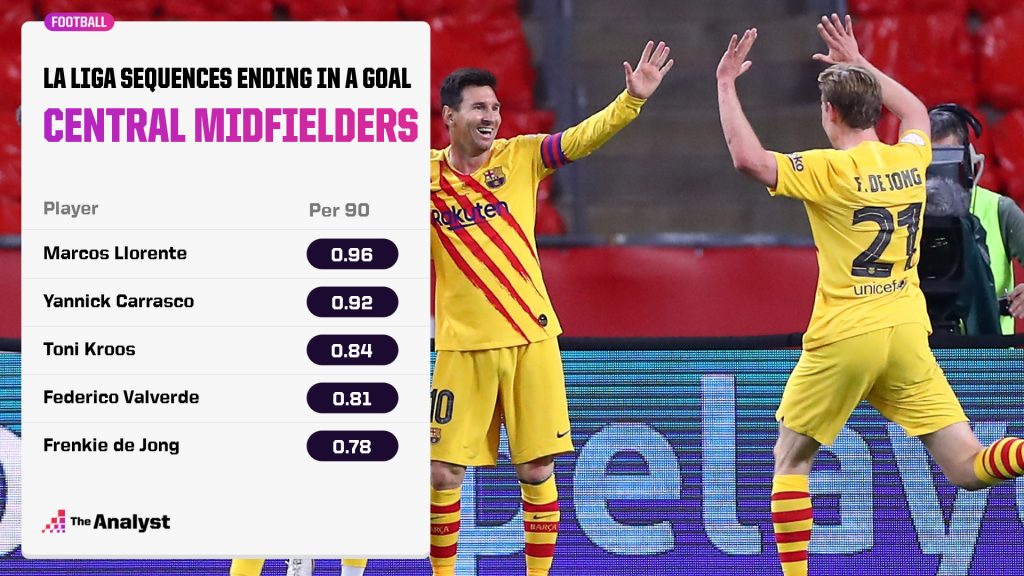
Quick tangent: Atalanta’s Luis Muriel averages a ridiculous 2.34 sequences ending in a goal per 90. That has nothing to do with this story, but if you’re his agent, you’re welcome.
Back to our 23-year-old subject. What has all this meant in terms of de Jong’s positioning?
Fewer touches in advanced wider areas with slight increases in the middle farther up the pitch. He’s had more touches in the defensive half as a whole, which makes sense given what we saw of his average sequence starting location above.
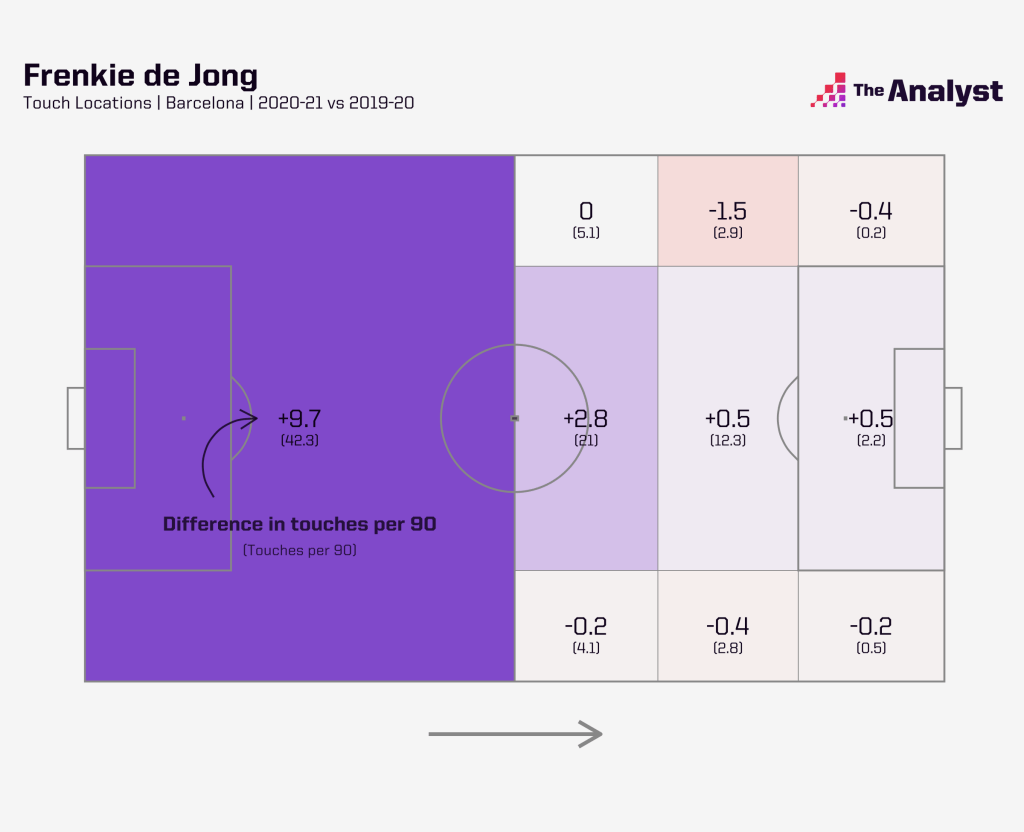
As for passing, he’s been more successful finding teammates in the most consequential areas of the pitch.
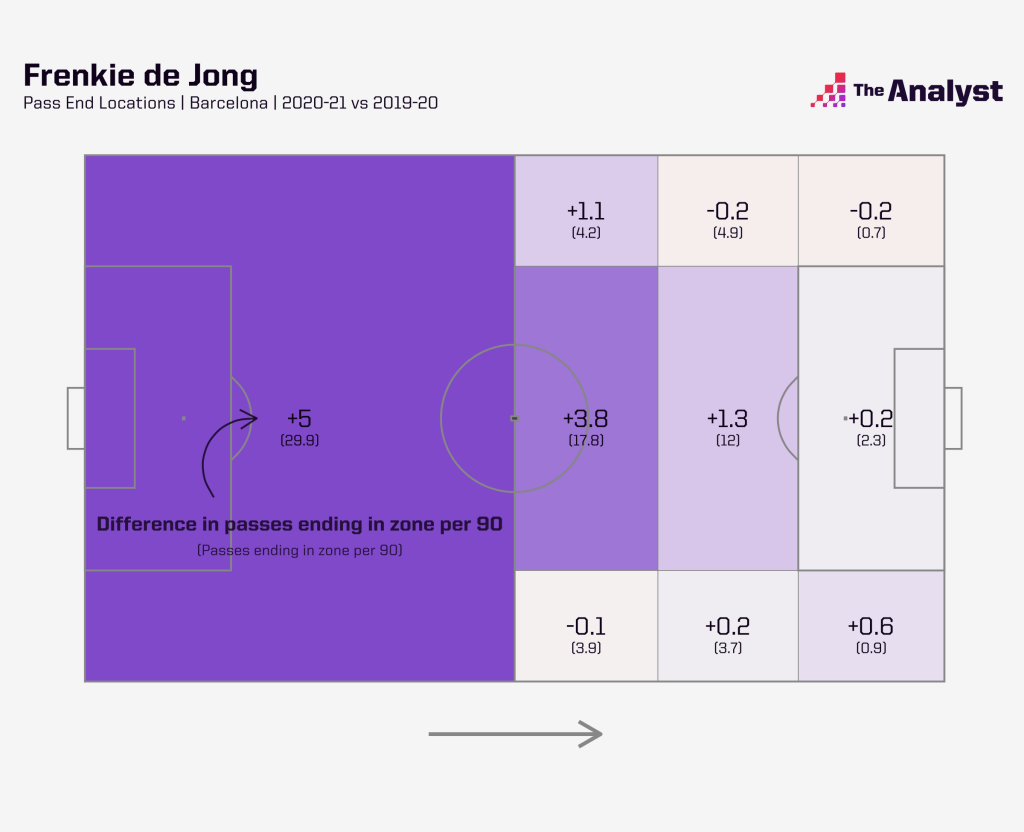
And recall de Jong’s uptick in ball carries pointed out earlier. Last season (left), his chance-creating carries were extremely limited and came from wider. This season (right), they’re coming up the middle with more consequential results.
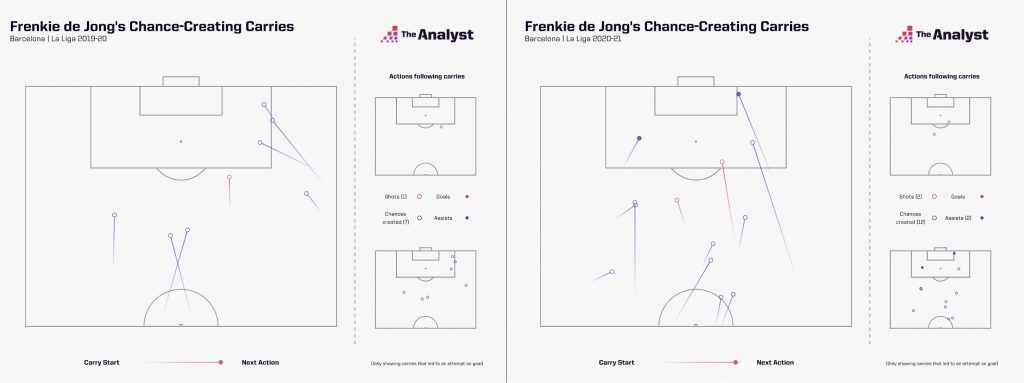
We already talked about take-ons and his increased rate in keeping the ball in that context, but there’s more to losing and winning possession to touch on. First, it’s encouraging to see his possessions lost decreasing across three seasons.
De Jong Turnover Numbers:
| Club | Possessions Lost | Recoveries | Interceptions |
|---|---|---|---|
| Ajax 18-19 | 10.92 | 8.59 | 1.78 |
| Barcelona 19-20 | 9.23 | 6.03 | 1.03 |
| Barcelona 20-21 | 8.61 | 5.96 | 1.23 |
Now, to anyone still wondering where he should be on the pitch, there’s perhaps something larger to discuss concerning what de Jong’s role will be in the squad going forward. Sergio Busquets is not long for a featured role in the middle of the pitch at a European giant, and in reality Barcelona probably should have tried something new at that holding position a few seasons ago.
With de Jong, there’s always been a fascination with moving him deeper, at times to the backline because he’s seen as a versatile player. But whether this would be effective probably depends on the kind of deeper player Barcelona would expect him to be. He’s clearly shown an ability this season – and with Ajax – to be a progressive player, even if he does it from safer positions. If they were to ask him to be a deep-lying ball winner, some questions arise.
In his time at Barcelona, his ball recoveries dipped considerably from where they were at Ajax. Say what you want about him not having the opportunities because he’s playing for a possession-based side, but the reality is Ajax had 63.4% of the ball in Eredivisie matches his last season there. Barca have 65.1 this season. De Jong is 32nd in La Liga with 6.37 recoveries per 90, then 38th (2.58) in the defensive third and 41st in the middle third (3.15). His interceptions are also underwhelming, though they do increase in Champions League where Barca face tougher competition and have less of the ball. This isn’t to say he can’t be a ball-winning midfielder, but what’s the reasoning behind wanting to find out? It’s a role Barca could certainly use, but that doesn’t mean it should be him. He’s spent nearly two seasons becoming himself again. Does it make sense to disrupt that?
De Jong peaked at Ajax in 2018-19 with highlight-reel football. It came with pace and skill that often revealed something new with each camera angle, and after you saw each camera angle, it was often compelling enough to watch it again. It was that – not his eight or nine ball recoveries per game – that Barcelona pursued. They now have it.
Design by Ruben Diaz.
